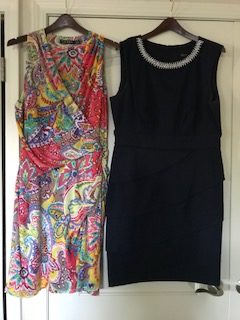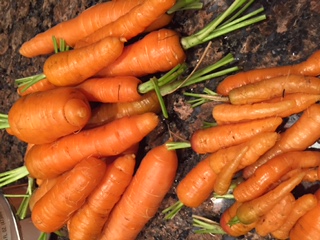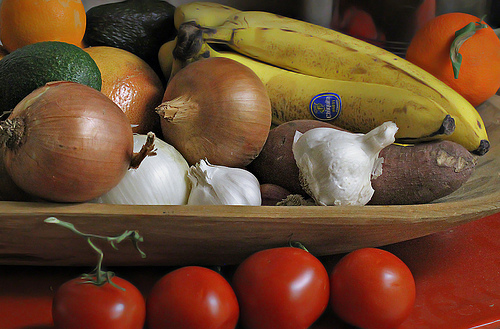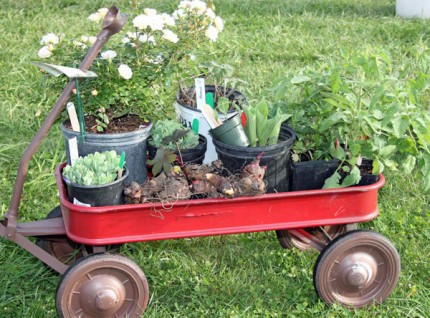Archive for the ‘Frugal Living’ Category
Why I Stopped Buying Clothes in 2018…Sort of
It’s not because I decided to stop wearing clothing, I can assure you of that!
In my frugal farmgirl world, clothing is one of the “four walls” of life (housing, food, clothing, transportation). It’s probably part of your four walls too.
But, the kind of clothes, or the brand and designer of clothes is a completely different matter. Clothing, yes, it’s important. A $500 suit for work…not so much.
When I took a cold hard look at how I wanted to increase my savings and thereby increase my investing, clothing was one category that rose to the top of the list. Not because I spend enormous amounts of money on clothes, or because I’m a clothes horse, on the contrary. In a normal year I don’t spend a lot on clothes, or so I thought. This is where reality met the road, as it were.
I thought that because I was shopping super clearance sales, using coupons and combing thrift store 50% sales I was making a killing. What I quickly found out was my clothing expenses were killing my budget. Sometimes I really hate Quickbooks!
Don’t get me wrong, my clothing expenditures were still modest by normal standards. But who the heck wants to be normal? Normal people are usually broke.
My decision was pretty much made for me right then and there. I felt at this stage in my life I had enough clothes in my closet to get through the work week, enough grungy clothes for farm chores, enough nice pieces for social events, and enough items I could cobble together for vacations.
Simply put…I didn’t need any more clothes.
There it is. The challenge was set. I would forgo buying clothes beginning with in January 2018.
I spent a weekend reorganizing my closet and assessing my wardrobe by clothing type—work, casual, jeans, seasonal…you get the idea. This worked out well. I started putting outfits together in my head with what I had available, and felt confident this was not going to be difficult at all. Only one small problem, I’m a thrift store hound. I love combing the racks finding deals on top notch designers for pennies compared to the retail price. I thought, “How can I pass up such a great deal?” But it was this kind of thinking that lead me to spend more than I needed to in the previous years. The only remedy was to go cold turkey. You heard me right. Not step foot inside a thrift store for all of 2018. And so far, I’m proud to say, my only trips to the thrift store have been to the back door to drop off donations rather than shop.
And, ya know what else? I haven’t missed it one bit. My self-imposed clothes buying hiatus has paid off in more ways than one. I no longer make a trip to the thrift store part of my Saturday errand running routine. I no longer swing by the mall on Sunday just to see what’s there. I no longer have the month-end 50% off thrift store sale marked on my calendar, and I no longer tie my abilities, intelligence, skills, work ethic or worth to my clothes. I’m just as smart, work just as hard and accomplish just a much in an outfit that is year’s old. And, I’ve really begun to dislike the phrase, “look the part”, meaning dress in expensive clothes so people take you seriously, or you look more professional. Don’t get me wrong “I do” dress appropriately for meetings, presentations and social events. I haven’t reverted to wearing a feed bag, but the label on my clothing no longer drives who I am as a person, a competent person.
I think I’ve only stepped foot inside a department store 3 or 4 times this entire year. And this is where the “sort of” comes in. When I first started my no clothes journey I had $125 in gift cards from Macy’s and I knew I would be getting a few $10 off cards from Kohl’s. I’m not one to pass up free money, are you? So I strategically determined what I needed based on my closet reorganization and this is what I decided to buy, or try to buy, with the $125:
- Under garments
- Evening dress for a work event
- Black slacks
This is what I was actually able to buy.
- Under garments (regular price, $55 each. Sale price, $40 with a buy one got one ½ off)
- Dark blue evening dress (regular price, $139. Sale price, $39.99 with another 20% off)
- Skinny leg black slacks (regular price, $75. Sale price $24.95)
- Mustard colored casual top (regular price, $24.95. Sale price $12.95)
All told, I spent $129.89. True, I didn’t get everything for the amount of the gift card, but my outlay for almost $350 in useful clothing that I will wear for years was just $4.95. Not bad, folks!
SO—this is where the “sort of” in the title of this article comes in as well. I occasionally get super offers, like $25 off any purchase of $25 or more, or $10 off any purchase of $10 or more, and I’m not willing to let those go to waste just to adhere to my self-imposed moratorium on clothes, because eventually I will need to replace clothes. I use these offers very strategically though, on things I know I will need or on pieces that are versatile enough to create new outfits with the pieces I already own.
So what have I purchased with these offers, you may wonder?
- A $25 birthday gift card from J Crew got me a V-necked cotton sweater and a teal tee shirt off the clearance rack. Total price: $28.15. My out-of-pocket: $3.15.
- One $10 off offer from Kohl’s got me 2 cami’s that I use to layer. Total price: $0
- Another $10 Kohl’s offer got me a short sleeve and long sleeve tee that I can wear under sweaters or blazers. Total price: $12.06. My out-of-pocket: $2.06
- A Nordstrom Rack coupon got me a pair of much needed pumps for $30.
- My one non coupon purchase of the year was a short and long sleeve tee from J Crew. Out-of-pocket: $7.15.
So—what does a frugal farmgirl wear for work, chores, casual and fun?
For my day job, I mostly wear casual pants with a nice top or sweater in the colder months. If I have meetings, presentations or speaking gigs I wear a more traditional work outfit that consists of slacks or skirt; blouse, cami or shell, and a blazer.

For chores, I usually wear an old pair of Levi jeans that I bought for a dollar about five years ago, and any number of free tees that I’ve received for volunteering at charity events.
Casual outings, concerts in the park, street fairs and festivals will find me in an array of jeans, shorts, skirts and various tops, sweaters or coats, depending on the weather.

I’ve had gala events for work, special celebrations, funerals, family events and gatherings with friends, and I’m sure these will continue in the years to come. But, here’s the reality: I’m okay with wearing an outfit I’ve had for years. I’m okay with wearing thrift store finds or hand-me-downs from friends because I frankly don’t care that someone else thinks I should change out my wardrobe at the turn of every season. And, I’m pretty sure that no one at the gala knew the dress I was wearing was free with a gift card. Over the years I have acquired an array of accessories that enable me to change up outfits to look new and modern, or casual to dressy, and I’m just fine with that.

These days I’m more interested in acquiring life experiences than acquiring possessions. I don’t want to feel owned by my clothes or other possessions, obsessed about whether I have the latest trendy style. I’m comfortable in my skin and in my clothes. A person’s style is their own, to express themselves in a variety of ways. I love switching things up—from country girl to boho to tailored, because I am all of these, and I love it.
I’m grateful for the time I have NOT spent shopping because I’ve been able to fill the time with more productive pursuits, like yoga, hiking, spending time in nature, exploring new areas of my county, reading and educating myself. Just yesterday a friend and I packed a dinner, fruit, dessert, water, and chairs and headed to the coast to watch the ships come in while the sun set over the jetty. It was beautiful and relaxing. If I had spent the day shopping, or mindless wandering the stores I would have been too tired to enjoy such a wonderful evening with a good friend.
My other motivation for not buying clothes is the increased amount of money I can save. This is a priority of mine for 2018. I want to increase the percentage I save in all areas, not just clothing. This increase will eventually translate to increased financial independence. It seems like a small step, but small steps are how we cover long distances. I view this as part of my journey towards a satisfying and fulfilling retirement; one where I have a great outlook on life and meaningful experiences. If I have to give up buying new clothes to reach that goal then I think it’s a worthy trade.
I’m not sure how long I will continue my clothing moratorium, but if I continue getting great coupons that allow me to purchase a few new pieces while only spending a few bucks then I think I’m in it for the long haul.
As of August I’ve spent $47.31 and added 12 new pieces of clothing. I can live with that.
Frugal & Fabulously Fun Entertainment Ideas

The 4th of July holiday means the summer entertaining season is in full swing, with long sunny days that last deep into the late hours you can’t help but want to be out of the house for as long as possible.
I sometimes think that people assume I just sit around my homestead reading books by flashlight to save money and dining on the remnants of my refrigerator. In reality, though, nothing could be farther from the truth. My life is full of frugal luxuries…as I see them…in the midst of an abundance of frugal opportunities. If you know where to look, free or almost free activities abound. There’s a lot to be said for contentment in the simple things.
Case in point: A local private university has a fantastic School of Arts & Music. Several times each month they hold concerts or gallery showings of featured artists. I have made it a goal of mine to explore all the school has to offer in the way of arts and culture. Up until now I have not done such a great job, unless you count the variety of business networking meetings or State of the City events I attend on said campus, so a recent Dragon Boat Festival was the perfect opportunity to get started.
(The Dragon Boat Festival is a traditional holiday that commemorates the life and death of the famous Chinese scholar Qu Yuan. The festival, full of Chinese dance and music, occurs on the 5th day of the 5th month in the Chinese lunisolar calendar).

Adhering to my goal of $0 to little expense on entertainment I was able to frugalize my evening with great accomplishment. I packed a light dinner of cold sliced chicken, veggie salad, cut fruit and spa water (basically water with cut fruit in it, fancy I know), which I ate amongst the gardens of the campus. Over the years I have put together my picnic pack for little to no money. My folding chair was purchased with a Costco gift card that was given to me. The lidded picnic basket was found at a thrift store 50% off sale ($2.50, and included dishes, glasses and flatware), and a small throw that can be used to sit on the ground or as a table cloth. You never know what has been atop a picnic table in a public place. If there is truly a question about what may have touched said table I can always use the table attached to my chair.
As I discovered from the event photographer, the Dragon Boat Festival is put on by the local Chinese community to introduce and educate people to the art, music and dance of the Chinese culture. I was also delighted that the ticket price was $0 as this was a cultural outreach program in conjunction with the university. This was an amazing opportunity for a frugalite like me! I was so thankful to walk the gallery strewn with works by local Chinese artists and to see a special exhibit of traditional Chinese garments.
But this was all just a prelude to the main attraction of Chinese folk songs played on traditional Chinese instruments; dancers in colorful, billowing costumes and a choir singing traditional songs of celebration for a man that is renowned in China. During intermission I lounged in the foyer chatting with members of the group who told me more about their culture and traditions.
I’m a great lover of art and music and try to partake anytime I can (meaning anytime it’s free or cheap). Although I don’t play an instrument, nor do I have a talent for singing, I was employed by a local symphony as a donor relations manager and acting liaison between the fundraising committee and the staff, which coincidentally regularly served food at their meetings (aka free meals).
It may be surprising to know that frugal little me actually owns a few pieces of “real art” that I paid real money for. I may be frugal, but I also believe in investing in quality things that matter to me and will bring me joy.
While not everyone has a local university or community college, there are a plethora of other options you can employ; concerts in the park, pop up art exhibits, library programs, even free or low cost museum days. The point here is to seek out what is available in your area and start getting out there to participate.
My evening was capped off by a leisurely stroll through the campus as I made my way on a circuitous path back to my car. The internet is a great resource for entertainment and information with amazing breadth of knowledge on-line for “free”.
This completes my frugal night of music, art and cultural of a people I was not really familiar with. I’m often asked how I live such an interesting, seemingly luxurious lifestyle on little to no money, and to me, its second nature. I avail myself of whatever’s free and rarely engage in the rest. It’s easy to spend $100’s of dollars on mini-adventures like the Dragon Boat Festival, but in reality, there’s no need. With a bit of research and planning ahead (finding the event and packing a light meal) and being open to events as they presented themselves to me a frugalite can partake in a wonderful evening without experiencing sticker shock at the end. Flexibility, simplicity and the absence of the need for a “perfect” experience and a general devil may care attitude will ensure you can enjoy thrifty entertainment of any kind. Be open to it, folks.
What’s your favorite frugal outing?
Need a few ideas? Below are 12 of our favorites (there’s a whole lot more), created over years of seeking out frugal fun. Add your own as you discover what’s available in your area.
- Art Walks (Art crawl)
- Public Gardens
- Pop-Up Art & Music Events
- Concerts in the Park
- Free Yoga in public places
- Whale watching with a picnic lunch
- Sea Lion viewing with a picnic
- Free Museum Days
- Concerts/lectures/cultural programs at local university or community college
- Free library programs
- Free surfing competitions
- Open Artist Studio Tours
My Ultimate Guide to a Frugal Pantry & Healthy Eating

Grab a drink and a chair, folks. This is gonna be a long one.
In the world today, monthly payments on a vehicle (or two) are at the top of the list of family expenses. Second to that is the cost of groceries. Whenever I get together with friends or family or for a potluck somehow the conversation always circles around to the cost of food and “how can I save on groceries?!” It’s a darn good question too because unlike other budget items we can cut back on or eliminate (think clothing, take-out, fancy coffees or cable), food is a necessity. Although it is true that food IS a necessity, it is also true that expensive food is NOT. I fashion my menus and my shopping around my favorite Paul Fussell saying: “I can feed better at home”.
Over the years I have updated, changed and turned on its head the ways in which I save on groceries, prepare meals and basically treat the subject of food. I’m going to outline the most complete, scrumptious rundown of our frugal pantry, food and meals that I can manage. You’ll find many more posts in my “In the Kitchen” & “Frugal Living” sections of the blog and I encourage you to peruse those posts and the recipes, because it will show just how well we eat without spending a fortune on food. I also encourage you to look through the recipes because I won’t be posting any here, as this post is more about how I save money on food.
With that said…here we go.
First and foremost, when talking about food and food budgeting you have to do two things right away in order to have any success.
- Jettison the Excuses.
- Identify your Boundaries.
Excuses: You know what I’m talking about, I know you do. That little voice in your head rationalizing why you NEED eight different flavors of coffee creamer or why you have to keep an array of “treats” in the house because if you don’t there will be mutiny. If you want to get a handle on your food budget, doing away with the excuses is a must or you won’t be successful. Instead of lamenting what you think will be lost, start building a mindset of gratitude and anticipation over really looking at how you can eat better and spend less. Remember: frugality IS NOT deprivation.
Some of the excuses I hear when I talk about frugal eating:
- You don’t know what it’s like shopping and cooking for a large family! (Oh yes I do! I come from a family of 5).
- I’m a one person house and it’s hard to cook for one person! (News flash…I’m single too!)
- I eat vegetarian (or vegan) and those foods are really expensive!
- I can’t go a meal without meat, and meat is expensive!
- All the recipes are complicated and I hate to cook!
- I love trying new recipes so I’m always buying special ingredients! (Yay, I get this one, trust me. I’m a foodie, too)
No joke…these are common excuses I hear ALL. THE. TIME. While the differences might be funny it also shows just how hard people hold onto their beliefs rather than be willing to change their thinking, like it is possible to be frugal and eat well at the same time. In a word…YES!
I do realize that every person’s situation is different and that my household of two (now one) is not the same as, say, my mom’s situation of raising three kids, or my friends who have 5 to 7 kids. Obviously, I spend less on groceries than a larger family, but let’s not use comparison as an excuse. Try to glean information that can be useful to you, finding ways to reduce the amount of money you spend on food. So, identify your boundaries and preferences for food (mine are: lots of fresh, whole foods, vegetables and fruits) and embrace them, leaving the excuses on the sidelines.
As with other aspects of your life, make food choices that matter to you, but remember…not everything can be a priority. Remember also, the general category of “food” is not a viable priority. Be specific about what you value and write it down.
Where to Shop
Where you shop will have a big impact on your food costs. Constantly shopping at the same store because it’s “on the way home” or “it’s where I’ve always shopped” could be biting into your food budget if you don’t know for sure that you’re getting the best prices. Comparing prices from store to store will let you know which has the lowest prices. One caveat here: I’m not advocating that you run all over the county to buy a few lesser priced items miles from home. That’s not frugal! What I am advocating is doing your due diligence. If you need to stock up on rice or peanut butter you won’t know which store is cheaper unless you compare prices!
Here’s what I did: early in my frugal path, I made a list of the most commonly used foods in my kitchen and priced them out at the stores in my area—a restaurant supply store that is open to the public, a big box store where I buy my gas, the chain stores and an ethnic market.
Once you have this information you can shop at the store that has the lowest prices on most of the items you need, or you can shop at several stores if they are not out of the way. I primarily shop at one store because their prices on produce is consistently lower than any other store, but I usually don’t buy staples, frozen or bakery items there because I can get better prices at the chain stores. Weekly grocery store circulars can be a big help here, if you get them.
(I can remember combing through those circulars with my mom as she planned the weekly menus based on what was on sale that week. I bet you have a similar story.)
It may sound time consuming to shop at multiple stores, but if you go armed with your list and stick to only the items you need rather than roaming all over the store it’s not that bad. I’ve created a routine over the years where I do my grocery shopping and errands on Saturday morning. The tricky part is mapping out my journey so perishable items are not sitting in the car for too long. Fortunately, all the stores I shop at are within a few miles of the gas station where I fill up my tank every Saturday morning. Although I’m not a big on-line shopper for regularly purchased foods, I do compare on-line prices when buying bulk non-perishable items like seasonings, grains and nuts.
Let’s Talk Ethnic Markets
I’m letting the cat outta the bag here. The store I shop at most often is actually an ethnic market that caters to the Hispanic and Indian populations in our area. Why? You may ask. Because they have a great produce section where I can buy reasonably sized produce, not huge specimens, and they consistently have the lowest prices than any other store in my area. I routinely buy items to fill in when the garden is young, or the crop is low. Imagine buying carrots or onions for 25-cents a pound, or potatoes for 50-cents a pound. They also have rocking specials on meat. Several times a year they have chicken quarters for 39-cents a pound, with a 20-pound maximum. Where else can you buy 20-pounds of chicken for $7.80? If you do know of another source I’m all ears!
Be Cautious with Coupons
I’ve had a serious love hate relationship with coupons over the years. On the one hand they are great if the coupon is for something you would buy anyway, but more times than not they entice consumers into buying something they hadn’t planned on, or may not even eat, which puts a dent in your food budget and wastes food. My advice…if you don’t have the control to say NO to a seemingly great deal, don’t use them!
Even though I have used coupons over the years, with great savings, I have to watch myself to make sure I’m not falling victim to the marketing ploy. You’re not saving money if you’re buying something you don’t need! Secondly, and more importantly, coupons are usually for brand name, pre-packed or pre-made foods that are much more expensive than their homemade counterparts. My philosophy has always been to shop the outer isles, which is where the “whole foods” are.
When & How to Shop
Old habits die hard, I get that. But, when you shop and how you shop will have a positive or negative impact on your overall food budget and your ability to save on food expenses.
Don’t shop when you’re rushed for time. As a busy single mom I completely understand the luxury of “extra time”, it doesn’t seem to exist, but do the best you can. Shopping when you are rushed lessens the time you take to really think about what you’re purchasing and what you’re spending on certain items. Calculating costs seems to also go out the window when you’re rushed. You tend to just grab and go, not putting much thought into what goes into the shopping cart. To get a handle on your food expenses you have to slow down and shop with purpose. Shop in the evening without the kids or shop when the kids are busy with afterschool activities. Be creative and find what works in your situation. When Brianne was at home I would shop on the days she was with her dad. Now that she’s out of the house, Saturday morning seems to work best. I don’t shop during the week because I hate running errands after a long day at the office.
It wasn’t always a burden shopping with Brianne. If I did have her along, we would play divide and conquer. I would give her a few specific items with a particular price point to pick out on her own. Example: variety of apples or type of cheese…her choice. This gets older kids into the habit of looking at what they buy, what the price is, and if there is a cheaper option.
Always shop with a list and stick to it! Make your list at home before stepping foot inside the grocery store. If you’ve taken the time to look over the fridge and pantry you’ll know what you need and what you don’t, so you’re not buying something you already have, while leaving out something you actually need. This is a great time to ask if there are any specific requests other people in the house might have.
Don’t shop hungry! This is not revolutionary, I know. But, it really does make a difference to your food budget bottom line because a rumbling tummy can be a huge distraction as you pay more attention to what you can grab and eat in the store rather than the best price on cuts of meat. The best time to shop is after you’ve eaten (hence my Saturday morning shopping routine). If that isn’t possible, at least take along a snack and nibble in the car on your way. That way those easy open, filling, processed food items won’t be calling your name.
What to Buy

This area will be based a lot on food preferences, dietary considerations, medication restrictions and priorities. In essence, every person’s choices will be different.
There is a general guideline that I adhere to that should work for your particular situation: shop the outer isles. The perimeter of a grocery store is where you will find the majority of whole, fresh, raw, unprocessed foods. Think about that for a moment. The produce section, meat department, dairy and egg case are all on the perimeter of the store. There are some exceptions of course, the bulk bin section, if your store has one, oatmeal, baking goods, like flour, sugar and salt, etc. are on the inner isles, but for the most part what’s on the inside isles are mostly expensive processed foods. If you stick to the outer isles you’ll have less expensive, wholesome foods in your cart.
I’m also a huge advocate of bulk shopping, something I’ve done my entire adult life. With a farm to manage, livestock to tend, a child in school and everything life can throw at you it just makes sense to have a well-stocked pantry. I also live by my own motto of: “last one, buy one”, which basically means that when I open the last container of something, whether it be a condiment or oatmeal, I put that item on my shopping list. Buying in bulk also enables me to take advantage of sales and stock up on items I use regularly at a lower price.
Disclaimer: for the most part, my well-stocked pantry means I have multiples of many items. I don’t just buy a one-pound bag of split peas or beans for soup; I buy 5 or 10-pounds in bulk and repackage to fit my needs. I also check the Manager’s Specials in the meat section to see what is at a super discount. I routinely find tri-tip, top sirloin, short ribs, and pork roasts for just a few dollars, which can be frozen for later use.
What I mean by whole foods:
- Whole foods are the raw unprocessed ingredients needed to make a particular dish rather than buying its pre-made equivalent.
- Rather than buying a jar of salsa, buy the ingredients to make your own: tomatoes, onions, chilies, olive oil, and cilantro.
- Rather than buying pre-cut packages of fruits and vegetables, cut your own. Did you know that dipping cut fruit, like apples or peaches, into a bowl of water with the juice of half a lemon will help keep the fruit from turning brown? And, that root veggies like carrots, beets and parsnips last a long time in the fridge?
- Rather than buying expensive sweet breads like pumpkin or banana, buy all the ingredients and make your own. Or, better yet, work towards having the ingredients on hand so you can make it anytime.
By looking through your pantry, fridge and freezer you can see what pre-packaged foods you buy, and plan to make them from scratch, saving you a ton of money.
What I mean by not buying processed foods:
Simply put, these are any foods that are NOT in the raw ingredients. Think pre-formed sausage or hamburger patties, or canned soups. Buying the pork shoulder and seasonings, and making your own homemade sausage is much cheaper. Cooking down a chicken carcass and adding veggies, herbs and rice will produce a big pot of soup for multiple meals. Making your own meals is healthier as well because home-cooked meals are not full of preservatives and sodium.
Buying whole ingredients in bulk and steering clear or processed foods is the cornerstone of frugal healthy eating.
Dine-In Rather than Din-Out

I struggle with this one, too. Eating out or getting take-out is a hard one for most people to overcome, because they enjoy the socializing aspect, the convenience of not having to cook after a long day, or they have a few gourmet dishes that they think are too hard to make at home. I’m not suggesting you do away with eating out altogether, although that is the direction I’m heading with this. Let’s be honest…portions are WAY too large, the calorie, sodium and fat content is more than is good for us, eating out is expensive and more times than not it’s very fattening. What I am suggesting is that you realize that with a bit of planning and a well-stocked pantry you can prepare most, if not all, of your favorite foods at home for less than you’d spend at a restaurant.
Here are a few ideas to consider:
- My sister has a group of friends that meet monthly for a simple meal, usually soup & salad; chili & cornbread; pasta, salad & garlic bread. Sometimes they do a potluck where each person brings a different course and the host makes the entrée. The point is that socializing doesn’t have to be at a 5-star restaurant, or even a 3- or 4-star for that matter. What’s important is that good friends are getting together in love and friendship.
- I have a group of ladies that meet during the warm summer months for water aerobics and potluck. It’s the same house each week, because she has the pool and she loves to host. We each bring a favorite finger food to share. Sometimes we have theme nights like Mexican, Asian, Picnic, etc. Have fun with it, be creative! Don’t have a pool? How about lawn bowling or croquet?
- When I find a new recipe to try and it makes much more than I can eat or want to freeze I hold a Guinea pig party. Anyone willing to try a new, unknown dish is welcome to come. I haven’t poisoned anyone yet, just in case you’re wondering.
- When we decided to start eating out less (not that we ate out a lot to begin with) we made a list of all our favorite dishes and began searching for copycat recipes on the internet. I’m sure you’re already aware of the plethora of food blogs with great recipes that can be found. Think “The Julie and Julia Project”. It was during one of these “new recipe” events that I taught Brianne how to make Julia Childs’ famous Beef Bourguignon. Yes, it was an all-day affair, but it was a great mother/daughter time as well. Amazing things happen when you cook with your kids…no matter what age they are.
These are just a few ways to ease into not eating out. I’m sure you can think of more. If eating out is an absolute necessity, but you still don’t want to bust your budget, consider reducing it to once a month, share a meal, forego the beverages, and factor the expense into your budget. This way eating out becomes more special than routine. Plus you can consider a more gourmet restaurant rather than the run of the mill coffee shop.
Meals at the Ready — ( Freezer Meals)
Life is unpredictable, I know. Traffic, meetings, sports events, school events, lambing season, calving season, show season, frost season, you name it, any number of events can make you late getting home with no time to cook, so you grab the phone and call the pizza delivery guy. Do you have him on speed dial? ‘Cause we’re gonna break you of that right now.
Any frugal household (including mine) will tell you the two saving graces of life are:
- A slow cooker, and
- Freezer meals
I seriously think a slow cooker should be gifted to every single parent. Here’s why:
Imagine you’ve just had the worst day of your working life. After sitting in traffic you arrive at your child’s school only to find out that volleyball practice has been extended for another hour. The fact that you are 30-minutes from home doesn’t help either. When you finally get home, animals want to be fed, the dogs are going crazy, the kid smells from hours of sweating, and just when you want to fall down here comes the all too common question…”what’s for dinner, mom”? Sound familiar? In your previous, not so frugal life you would have pushed that speed dial button for the pizza delivery guy, but not anymore because you have joined the ranks of frugal food weirdoes.
In all of these situations I didn’t have to get take-out because I either had the slow-cooker bubbling away on the counter or I had meals already prepared and waiting in the freezer.
At any given time (or season) I have soups, chili esand stews in the freezer. No matter what the situation is that brings us home late or the disaster that strikes, like a broken water line or a lamb jumping over the fence and slitting his side open on a t-post (true stories , both), we can still sit down to a warm hearty meal at the end of a long, stressful day.
Anytime I’m making a batch of soup, chili or stew, I always make an extra batch to freeze. I portion it out into 24-ounce square freezer containers (I’m not a huge fan of Ziploc bags. Why buy something so you can throw it away?). This is just enough for two portions, with a bit left over for lunch the next day. They also stack nicely in the freezer.
I know from personal experience that with as much as I enjoy cooking, even “I” don’t want to cook every night. Having a stock of freezer meals means I can eat well without busting my budget. Nothing can derail a budget faster than getting caught having to buy take-out.
I also want to say, “be kind to yourself”, especially during the week. With everything that goes on in a week, why add to the stress by thinking you need to create a 7-course meal every single night. Save those impulses for times when life runs smoothly. For every other time, have a nice selection of meals to fall back on.
If you think we eat like the Food Network every single night I can assure you nothing could be farther from the truth. We eat simple meals made with simple whole ingredients. Think baked chicken, rice & salad; pork chops, smashed yams & green beans; or pasta, salad & garlic bread. There are several casserole dishes (and salads in the warmer months) that rotate in and out of our menu selection, too. As surprising as it may seem we pretty much eat the same rotation of foods from week-to-week, with an occasional new dish thrown in when we have the time. Even though I love to cook as much as I love to eat, I have better uses for my time and my money.
After years of preparing meals like this I also don’t do a lot of hardcore meal planning. I have in my head what I can whip up with what’s in the pantry. Depending on what I make, one meal may be eaten over several days as leftovers. We love leftovers! You may want to plan meals if you’re new to creating a stash of frozen meals.
Some of our favorite meals:
Chopped Salad – This has everything in it but the kitchen sink. The lettuce mix is just the canvas for chopped up meats, cheeses and a whole lot of veggies. Great way to clean out the fridge, too.
Orange Chicken Rice Bowls – This is great for leftover chicken, or cook a batch specifically for this dish. The rice has carrots, peas and broccoli in it. Once it is all mixed together the quantity expands exponentially, which makes it perfect for leftovers.
Green Veggie Sauté – I whip up a big batch of onions, mushrooms, spinach, green beans and asparagus into an Asian style sauté, which lasts for days.
Breakfast for Dinner – You always have plenty of eggs when you have layers, so why not turn mealtime on its head and have a frittata, scramble or just eggs and toast. Frittata’s and scrambles are a great way to use up a variety of leftover veggies.
Pasta Fagioli – This is a favorite, especially in cold weather. It’s hearty, packed with protein and perfect for freezing. There’s no way to make a small batch of this, just saying.
White Chicken Chili – Another favorite.
Anti-Pasta Platter – Perfect for those hot days when no one feels like heating up the kitchen. We lay out a combination of sliced meat (whatever we have), cheese, olives and whatever else we have. It’s usually paired with a seasoned olive oil, for dipping, rustic crusty bread and a simple salad.
Bruschetta – Another hot weather favorite. Grilled rustic bread loaded up with chopped tomatoes, basil and seasonings, paired with a Caesar salad.
Batches of soups, stews and chili are a great way to “clean out” the freezer. None of us are perfect and even I have had those packages of frozen meats or veggies hidden in the dark recesses of my freezer. After doing a thorough cleaning and super batch cooking marathon, I try (operative word…try) to maintain a strict “first in, first out” rotation of frozen foods.
Use Meat Sparingly

I have to say up front that I am a total carnivore. There’s nothing I like better than to cook (or grill) a good piece of meat! But, as we all know, meat can be an expensive part of your everyday meal. To combat the bloat of your food budget, use meat sparingly; giving it a supporting role rather than a starring role. If I make a roasted whole chicken one night, I’ll shred some and use it in lettuce tacos, or make a chicken stew. After I think I’ve pulled off all the meat, I throw the entire carcass into a pot to make a base for chicken soup. You’d be surprised at how much meat is still left when you think you’ve gotten it all. Left over beef can be chopped up and used to make Beef and Barley soup; a completely hearty and feel good meal. This way I’m extending the protein into multiple meals, saving time and money.
If I’m not raising a protein myself I’ll buy from a local producer. Traditionally, I‘ll buy a left over fair lamb from a 4-H or FFA member. Not only am I helping to support a young livestock producer, but I get a great product at a fair price. I have the lamb processed into steaks and stew meat, rather than whole cuts because they are more useful for my type of cooking. Meat also freezes well, so I also stock up on certain cuts when they are on sale (usually pork because I don’t raise hogs).
I also don’t eat meat at every meal. A few times a week I go meatless, but that doesn’t mean I’m scrimping on taste or protein. I just get my protein from other foods. My lunches are also primarily meatless. I’m a big salad fan (who wouldn’t be living in Cali), as well. Egg salad and crackers, hummus with pita bread and veggies, or whatever is hanging out in the fridge that needs to be eaten are all good lunch alternatives.
Going without meat a few times a week doesn’t mean you have to forego flavor or being full, but it does mean you’ll lower your grocery bill.
Have a Well-Stocked Pantry
Any meal is possible if you have all the ingredients you need without running to the store. This is where your list of most commonly eaten foods comes in handy. Once you know what you eat on a regular basis you can decide how you’d like to stock your pantry. This is important if you live far from town, have harsh winter weather or get stuck at home for some other reason. The point is…can you whip up a meal day-after-day, even a simple soup or stew, with just the contents of your pantry?
Having a variety of raw ingredients on hand also means you’ll go to the store less frequently and when you do go, your trips will be shorter. Sometimes I only go to the store once or twice a month because I have everything I need right at home.
My Basic Pantry Staples:
Rice – (white, brown, Arborio, jasmine) (kept in the freezer for long-term storage)
Beans – (white northern, kidney, Lima, butter, garbanzo)
Split peas
Steel cut oats
Pasta – (various kinds and shapes)
Oil – (olive and vegetable)
Butter – (salted & unsalted)
Vinegar – (various types)
Herbs & Spices (a whole lot of variety)
Potatoes & Yams
Carrots, onions & celery – (the three basics for almost every dish known to man)
Garlic – (fresh and dried)
Butters – (peanut, pumpkin and apple)
Condiments, olives & pickles
Flour, sugar, salt and other baking ingredients
Nuts, raisins & dried fruit
These are the foods I buy in bulk, because the per ounce price is cheaper. I replenish as my stock becomes low. They are also foods that are shelf-stable and will last for several weeks (or months) in proper storage conditions.
Stocking a pantry in one fell swoop can be an expensive proposition. You may enjoy about how to build up your pantry over time, here.
Snack Time
This is an area that can really wreak havoc on the grocery bill if you are not properly prepared. And, don’t think your will of iron will keep you from rushing to the first fast-food place or mini-mart you find when the hunger pangs begin. We’ve all been there. I won’t pretend we haven’t.
So…what is my plan for snacks? In short…to have them with me all the time! I take them to work, when I shop, go for a hike, run errands…you get the picture. This is especially important when you have little ones. Here are a few of our favorites:
Homemade trail mix; at least our version. Almonds, peanuts, dried cranberries, dried blueberries & chocolate chips. Hey! I’m frugal, not into deprivation.
Dried fruit – mangos, cranberries, blueberries, apples, apricots and of course, natures candy…banana chips.
Deviled eggs – back to the laying hens. I make these by the dozen, which really means 24 halves. They are filling, super tasty and packed with protein.
Edamame – boiled and salted and ready to pop into your mouth. They are great cold, too.
Popcorn – not a week goes by that we don’t have popcorn. I buy it in bulk from Win-Co.
Are Drinks Damaging Your Food Budget?
Along with prepackaged foods, drinks can put a serious dent in your food budget. To help combat this expense only buy them for special occasions. When Brianne was in grade school everyone thought she wasn’t allowed to drink sodas, but that was not the case. She was allowed to have them at picnics, beach parties, sleepovers and the like, if she wanted them, but they were not part of my weekly shopping list. As a result, she never acquired a taste for them and now she rarely drinks them. Side note: can I just say how crazy it makes me to see a toddler downing a full sized soda.
What we regularly drink:
H2O – yep…right outta the tap. It’s cheap, good for you and we don’t waste plastic bottles. Some people think it gets boring, but you can spice it up by making “spa water”. Toss some sliced fruit, ginger or cucumbers into a jug of water to give it a light refreshing flavor.
Tea – Hot or cold. I will just confess up front that I’m a tea freak. I like all kinds of tea, black, green, fruited, spiced, you name it. But, my go-to is iced tea. I usually make a small batch in the evening that fills my 24-ounce reusable bottle. When I’ve finished that, usually by lunch time, its water for the rest of the day. Like many coffee drinkers I know I can’t give it up, so rather than depriving myself, I just limit how much I drink. I look for sales on tea bags and stock up when the price is good.
Spirits – I’m not much of a hard liquor person. In fact, I cook with liquors more often than I drink them, but I do have a nip now and again. The airplane sized bottles are perfect.
Wine – It’s hard to live in California and NOT be a wine connoisseur. When I do buy wine I stick with Trader Joe’s and Cost Plus, and keep the price less to than $10 a bottle.
Frugality isn’t about depriving yourself. It’s about finding less expensive alternatives, which is the mainstay of living a frugal life. So buy what you love, just frugalize it!
Waste Not; Want Not

That pretty much sums it up. DON’T WASTE FOOD.
Did you know that 40% of all food produced in the US ends up in a landfill? Think about that for a moment. If you spend $100 a week on groceries, would you be okay with throwing away $40 every time you shopped? I bet not. What’s more astonishing is that if you are okay with the waste, you’d be throwing away over $2,000 a year! That’s not chump change!
Here are the most common reasons for food waste:
Buying more food than your family can eat. When you make a list and stick to it you end up only buying those items that you need and will use. Regularly cleaning out your pantry and freezer will help use up foods, reduce the amount of food you buy and help you to determine what you r family really eats each week.
Getting Sucked in by Sales on Items You Don’t Like. Everyone loves a sale. I get that. Even I’ve done this on occasion. But, the purchase is no bargain if you end up with foods your family doesn’t like and won’t eat, not matter how much you extol its attributes. Stick to what you know is healthy and what your family likes and will eat.
Choosing Take-Out Rather than Dine-In. Ordering take-out rather than eating food you already own occurs because of a lack of planning. Having a list of easy meals, that you can make in bulk, or using a slow cooker, will go a long way to reducing your food waste and thereby money waste. If done right, you could have a wholesome, homemade meal every night of the week for a fraction of the cost of a take-out dinner.
Waiting too Long to Eat Leftovers. To avoid food waste and the following waste of money, you MUST eat any leftovers. Not doing so is not an option. If this is not possible, then freeze the leftovers and eat them at another time. Conversely, if you have veggies that are not quite good enough for fresh eating, freeze them to be used later in soups, stews, casseroles or chili. Even the smallest portion of veggies can be added to any of these dishes. If your family doesn’t like leftovers, start cooking just enough for that one meal.
I realize that food waste isn’t entirely avoidable. There will always be some unusable bits. But there’s no excuse for trashing an entire pot of soup just because you got bored eating it, or you didn’t want the same thing twice in a week. I’m not hardcore on a lot of things, but having been in the food banking world for years has made me keenly aware of the waste. Tossing food is not only a waste of your money; it is also a waste of the time and resources spent to produce the food. I always encourage people to have a good way to store leftovers. I use reusable lidded freezer containers rather than Ziploc bags because you buy them once and use them for years, or in my case, decades. If you have chickens, they will devour veggie bits and pieces, spent lettuce and even crushed eggshells. If not, get a compost bucket and build your own soil!
Work Day Breakfast
I’m not known for being a morning person. Odd for a homesteader, I know. But I’m not. The last thing I want to do after jumping out of bed in the morning is fill my stomach with food. But that doesn’t mean I don’t eat breakfast. It just means I wait until later in the morning. The challenge with this is I’m usually already at work. My remedy: take my breakfast to work. My favorite breakfast is good ole fashioned oatmeal. Loaded with pecans and dried cranberries, and microwaved with a splash of milk and you’ve set yourself up for the entire morning. The added bonus is it costs pennies per serving and keeps you from running by a coffeehouse for a $4 coffee and a $3 pastry. Better for you too.
Hitting the Open Road? Take your Food!

Whether you’re going on a long trip or a short hop, never leave home without food and drink. Seriously, don’t do it. There’s nothing that will eat into your budget faster than constantly stopping to feed someone. Whenever I leave the house I always have a water bottle, a container of snacks and of course, a tumbler of iced tea. No matter what.
We got pretty good at this road trip food thing after years of weekend livestock shows and volleyball tournaments. We’d pack egg salad sandwiches for the drive, along with our trail mix (almonds, peanuts, dried cranberries and chocolate ships), homemade banana bread and plenty of cold drinks, because rule #1 on the road…”feed the driver”! No kidding.
Samples of our packed foods:
Pack a lunch for work or school. Pack it every day. To make this easier, pack the night before so that you don’t get caught rushing and forget. I do this while I’m making my iced tea. Our favorite lunches are egg salad, either on bread or with crackers, salads, soups and leftover whatever. Occasionally I’ll take homemade pate, cheese and rustic bread.
The workplace stash. This is similar to the road trip foods, but for your desk. Simple foods like trail mix, dried fruit, granola bars, even peanut butter and crackers can help fend off hunger pangs and keep you from heading towards the vending machines for a pick-me-up. If you’re lucky enough to have a fridge in your office, like I am, you have a lot more options. A container of cut fruit or cubes of cheese are a great energizer in the afternoon.
You can do this, I know you can! And, after you get into the swing of things spending $15 for lunch or $5 for a soda and chips will feel less like a luxury and more like a burden; a financial burden that is.
Just Dig in and Eat It!
With the best of intentions we have all had our version of the culinary epic failure. I know I have. So what do you do when a meal turns out to be less than stellar? Eat it anyway. Yep, we do…as long as it’s safe. And after it’s gone you can put that recipe in the “never to be made again” pile.
Don’t forget to check out the “In the Kitchen” and “Frugal Living” sections for more ideas on meals, recipes and saving money.
12 Ways to Find FREE Plants
There’s nothing I like better than getting something for free, especially if it’s something I need or really want.
As a suburban homesteader my world revolves around making the most of my little plot of land and that means green things growing; lots and lots of green things. From flowers and shrubs to trees and vegetables I use a variety of ways to get “free” plants to fill out my little farm.
If you need to fill in a garden space or start a brand new garden try these ideas to get you going, while saving a ton of money.
Earth Day – Many Earth Day celebrations give away plants and sometimes soil. Over the years I have gotten shrubs and trees for free, along with a bag of soil or a truck load of compost through City programs. And that’s not all I get. Our Earth Day features several community garden and garden club booths, many of which “give away” plant starts or started vegetables for free or for a small donation.
Local Garden Clubs & Community Gardens – Over the years I have become part of our local garden club and community garden efforts. Through these associations I have been able to get seeds, cutting, plants, divisions of bulbs and irises, and so on. Many of the community garden folks start way more seeds than they have space to plant, so they offer them up at monthly meetings.
Neighbors – Spring is prime landscaping (or, re-landscaping) time. Keep an eye out for neighbors re-doing their yard and ask if you can have some of what they are pulling out. If left up to the landscaper or homeowner, most of those plants will end up in a landfill. Better to have them adorn your yard.
Divide & Conquer – If you already have plants in your yard, see what can be divided, like bulbs or rhizomes. Or, check with friends and offer to help divide some of their plants for a few to take home. More times than not, you’ll end up with a lot more than you can use. Now you can share.
Forage for Seeds & Cuttings – Keep a watchful eye when running errands or traveling locally. Many times you’ll find seed heads ready to burst or plants that grow well from cuttings. It doesn’t have to be so local either. While traveling up north I stopped at a little market to refresh my drink and saw the most gorgeous hollyhocks coming to seed. I asked the cashier if I could have a few seed heads. After looking at me like I was nuts, she said yes. I quickly broke off a few of the dried pods loaded with seeds and wrapped them in a napkin. They became the beginning of a wonderful garden near my greenhouse.
Craigslist – The free section on craigslist is a great place to find free plants. Sometimes the ad requires that you dig up the plant, but most of the time they don’t. Even if you have to pay a few bucks it’s worth keeping track of. When my sister wanted to plant an iris garden she haunted craigslist for weeks before finding a gal who was pulling out her iris bed. Sis got 2 paper grocery bags full of irises for $5.00. When she got ready to plant she realized there were more than 100 rhizomes. Not a bad deal, even if it wasn’t free.
Trade – Gardeners love to share! If you have established plants and would like to add variety to your garden, try trading with other gardeners who have something you want.
Nursery Cast Offs – Not all plants at a nursery or garden center are sold. Some get over grown in their pots, while others get shaded out or covered up by other plants and don’t get enough sun or water. They look too shabby to sell, so they are tossed aside as “not sellable”. Some nurseries or centers, especially locally owned one’s, will gladly give away these sad little cast offs. Think of it as a rescue for plants.
Seed Banks – Some local libraries have begun offering “seed banks”, a place where local gardeners can drop off seeds from their own harvests, and pick up seeds from someone else’s garden. The best part is…no late fees, because the seeds don’t have to be returned. The library just asks that you share what you can.
ASK – This one seems so simple, but in real life it is the least used way of getting free plants. Every time I have admired a plant in someone’s yard and asked for seeds, cuttings, divisions, etc. I have always been told yes. There’s something so gratifying about having one’s yard admired that they just can’t say no.
County Extension Office – Many counties have Cooperative Extension Offices, which are the educational arm of government programs revolving around gardening, farming, and home economic subjects. Sometimes the offices offer free seeds as a way to encourage home gardening and food production. If you don’t find seeds, all is not lost because they have a wealth of information on many interesting topics from beekeeping to livestock production to food preservation, even hunting safety and archery.
Be a Seed Company Volunteer – When seed companies change their displays the company rep often times uses local volunteers to inventory and restock the display rack. As a thank you for helping, the rep usually gives the volunteers a selection of seed packets to show appreciation. For a few hours of my time last year I walked away with dozens of seed packets, and a few new gardening friends, too.
Frugal Friday – Volunteer at a Farmers Market
Farmers markets are a great place to buy local produce and talk with local growers, but did you know it’s a great place to volunteer? Most vendors can’t be at all the markets they sell at, so they bring in volunteers to help man their booth and sell their product. It’s a fun way to become part of the “inner circle” of your local market, and, you may even get paid in produce. You may even get enough to can.
Check with the organizer of your local farmers market to see if vendors are looking for help.
Frugal Friday – Don’t buy it just to trash it
We as a society spend hundreds of dollars each year buying items that we just throw in the trash. Sounds ridiculous doesn’t it, but it’s true. Trash bags are a good example. We buy them just to throw them away in a few days or a week. You might as well throw dollar bills in the garbage.
Try using paper or plastic grocery bags, or other shopping bags and save money for other purchases; useful one’s that is. I have not purchased a trash bag for more than 15 years, and I haven’t missed them. Sure using a grocery bag may mean more trips to the outside trash can, but I’d rather save the money to buy more seeds or garden supplies. Wouldn’t you?
Frugal Friday – Declutter & Sell, Sell, Sell
Long winter days that have us trapped inside is the perfect time to start going through those closets and cabinets, decluttering what we haven’t used in a while. But, don’t just donate the discards. See if they can be sold on craigslist, ebay, at a garage sale or local consignment store for cash. The cheapskate in you will love making money before donating the items, and you never know what people are looking for. If that puts a bit of green in your wallet, move on to the garage and earn even more.
To make the process less overwhelming start small, one closet, one cabinet at a time. I go through my house one drawer, cabinet, closet at a time throughout the year. Over time you will create a routine that keeps your house and mind clutter free.
Frugal Friday – Gleaning Fields
Not every homestead can have a huge orchard and vegetable garden, or even a small one for that matter. Lot size can make it difficult. But, did you know that many regional food banks have gleaning programs? That’s right! Food banks partner with local growers and backyard gardeners to glean excess fruit for low-income families.
Volunteers are used to pick fruit and vegetables from local growers and are sometimes rewarded with a portion of the harvest. Check with your local food bank to see if they have a gleaning program. You may just fill your house with produce while teaching your kids about giving back.
Frugal Living – Reassess your Bills
January is the time when I get all my tax paperwork ready. It is also the time I reassess my bills, like utilities, water, trash, insurance, etc., to make sure I am getting the best possible deals. This can be different from region to region across the county. Find out if there are alternatives to utilities and review the costs. If you can get a better deal elsewhere, switch. If you have a landline, check to see if they have a bare bones price or cancel options you’re not using.
Check how many cell phone or internet data minutes you’re using. If you’re not using all of them switch to a cheaper plan. Review the channels you watch most often on cable and reduce your package to get rid of one’s you don’t watch or seldom watch.
Bundle your home and auto insurance, if it’s not already, and ask your agent how a higher deductable will effect your coverage and monthly bill.
Little changes made now can save you money all year long.
Frugal Friday – “Eating-In” from your Pantry
To reduce your grocery bill and save a few bucks after all that holiday spending, dedicate the next 10-days to eating out of your pantry. Take a day and prepare meals using what’s on-hand from your pantry and freezer. This is a great opportunity to use up freezer items you’ve had for a while and learn new recipes using just the ingredients you already have. Only shop for essential perishable items, like milk, eggs and produce (if you don’t already produce them yourself). You’ll not only save money, but also have a chance to inventory your pantry, creating a list of “to buy” items.
To extend your savings even more “eat-in” for another 10-days and watch the savings grow. You may even be inspired to not spend on other items, like clothing, toys, or entertainment.

Recent comments
Aenean nonummy hendrerit mauris. Phasellus porta.